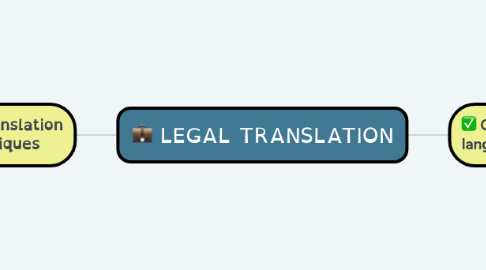
1. Characteristics of legal language
1.1. Legal lexicon
1.1.1. Complex and unique vocabulary
1.1.2. Pecularities
1.1.2.1. Archaic words
1.1.2.1.1. Such as
1.1.2.1.2. Formal and ritualistic usage
1.1.2.2. Word strings
1.1.2.3. Commons words with uncommon meanings
1.1.3. Dificulty
1.1.3.1. Non-equivalence between languages
1.2. Syntax
1.2.1. Formal and impersonal written style
1.2.2. Sentences
1.2.2.1. Long and complex
1.2.2.2. Serve various purposes
1.2.3. Use of
1.2.3.1. Conditions
1.2.3.2. Qualifications
1.2.3.2.1. Employed to express complex contingencies
1.2.3.3. Exceptions
1.2.4. Particularities to each language
1.2.4.1. Legal German
1.2.4.1.1. Use of attributive adjetives
1.2.4.2. Legal English
1.2.4.2.1. Passive voice
1.2.4.2.2. Complex structures
1.2.4.2.3. Multiple negations
1.2.4.2.4. Prepositional phrases
1.3. Pragmatics
1.3.1. Use of
1.3.1.1. Performative markers
1.3.1.1.1. Such as
1.3.1.2. Performative verbs
1.3.1.2.1. Such as
1.3.2. Ambiguity and vagueness
1.3.2.1. Found in statutes and contracts
1.4. Style
1.4.1. General use of
1.4.1.1. Impersonal style
1.4.1.2. Declarative sentences
1.4.2. Style in
1.4.2.1. Legal German
1.4.2.1.1. Abstract
1.4.2.1.2. Complex
1.4.2.1.3. Deference to
1.4.2.2. Legal French
1.4.2.2.1. Easy to understand
2. Translation techniques
2.1. Functional equivalence
2.1.1. States that
2.1.1.1. Meaning is first, form is second
2.1.2. Pays attention to
2.1.2.1. Form of the language
2.1.2.1.1. Form also has meaning
2.1.2.2. Meaning of the language
2.1.2.3. Spirit of the language
2.1.3. Wants
2.1.3.1. Readers of the translated text to
2.1.3.1.1. Appreciate the text
2.1.3.1.2. Understand the text
2.1.3.1.3. Comprehend the spirit and meaning of the original author
